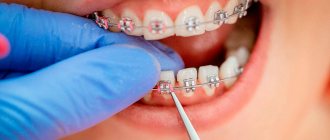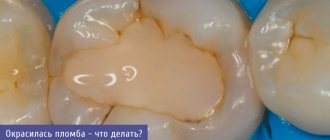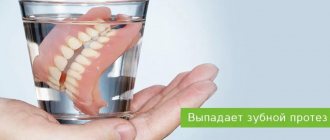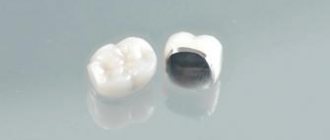Restoring a damaged tooth using a pin is a popular dental technique. A metal rod is fixed in the root canal, after which a filling or artificial crown is installed.
In order for the restored tooth to last longer, it is important to strictly follow the dentist’s recommendations, monitor oral hygiene, and limit the consumption of very hard foods. In some cases, complications may occur after restoration. One of them is loosening of the dental unit. Find out what causes it and how to solve the problem.
Causes of crown loss:
- the service life of the cement has expired or the composition was temporary;
- high loads on the tooth;
- spread of caries;
- hard or sticky foods;
- small teeth.
What to do if a crown falls out:
- Clean the tooth and crown.
- Secure the crown with dental glue.
- Contact your dentist.
What will the dentist do?
If the reason for the crown falling out is caries, the tooth will be cleared of the disease and a new crown will be installed. In this case, re-prosthetics or reuse of the old prosthesis may be necessary.
The service life of a crown is determined by its correct use:
- do not chew hard food or nails;
- do not tear anything off with your teeth;
- use dental floss and rinses carefully;
- Clean the crowns with a special brush at least twice a month.
Is it possible to glue a crown at home?
To place a crown or bridge, dentists use special materials that allow the orthodontic product to be temporarily or permanently secured.
Temporary type fixation is used to provide an opportunity to evaluate the structure while it is being worn. If there are no problems, the product is attached to permanent cement.
However, there are often cases when the crown falls out at home. The patient immediately begins to panic, especially if the crown was placed in the frontal area. In this case, there is no need to worry too much.
Why can our articles be trusted?
We make health information clear, accessible and relevant.
- All articles are checked by practicing doctors.
- We take scientific literature and the latest research as a basis.
- We publish detailed articles that answer all questions.
To glue the product in place, you can purchase a gel at the pharmacy, which is similar in composition to the temporary cement used by orthopedists. It is applied from the inside and pressed against the tooth. After the material has hardened, the excess is carefully removed.
To get a permanent crown, it is important to visit your dentist without delay.
If the crown and pin fall out together
The crown mounted on a pin is a reliable design. It can be placed in a tooth that is destroyed down to the gums or in the presence of thin walls. But if the installation technology is violated, the crown with the pin may become loose and fall out. There are several reasons for this:
- There were contraindications for installation - with thin root walls, cracks may form and fixation may be impaired.
- The pin or crown is uncemented.
- Inflammation in the area of the prosthesis.
- Increased chewing load – hard and hard foods in the diet.
- The patient should visit the dentist immediately.
What to do
If the crown falls out along with the pin, it is necessary to save the orthopedic product. It is not recommended to throw it away. To prevent deformation or damage, the structure is placed in a special container or box.
Since the stump of a dental unit becomes very fragile after treatment, it must be treated with extreme caution until the dentist installs the product again, since at this moment the risk of damage increases.
It is not recommended to put excessive chewing load on the tooth, or bite food with it. The hole in which the pin was placed must be covered with a cotton swab while eating.
All hygiene procedures before visiting a specialist are carried out carefully, the oral cavity is treated with an antiseptic solution.
If a tooth falls out
Losing a tooth is a reason to think about your health. The examination cannot be delayed; the situation should be corrected as soon as possible:
- determine the causes of tooth loss;
- prevent edentia;
- restore the dentition using a prosthesis or implantation.
Contact any of the Ultra Dent clinics in Simferopol if you notice problems with dentures. If the crown is loose, has fallen off, or you realize that the tooth underneath is rotting, make an appointment with your dentist without delay.
A crown fell out: what to do before seeing a doctor
So, the crown came off. You can’t immediately grab any technical glue you have at hand and try to glue it back. Some people make a big mistake using superglue. Its composition is very toxic and burns through living tissue. The dentist will not be able to reinstall a crown fixed in this way.
If a crown comes off, follow these recommendations.
- Wash the fallen crown with water, wrap it in a napkin and place it in a bottle or box so that it does not break before your visit to the dentist.
- Brush your teeth gently. Be careful not to damage the stump. Use rinse aid.
- Hold off on eating and drinking drinks (except water).
- Make an appointment with an orthopedic dentist as soon as possible.
- If pain occurs, take a pain reliever.
How to glue a fallen crown at home?
If it is not possible to visit the dentist in the near future, the fallen denture can be temporarily glued back. Pharmacies sell dental cement, which is used to secure a fallen-off denture.
- Mix the glue ingredients according to the instructions.
- Apply cement to the washed and dried crown.
- Put it on carefully. If the denture does not fit easily into place, do not try to force it in to avoid chipping the tooth.
- Press the crown onto the tooth with your fingers for 1 minute (without being too hard).
- Then close your teeth for 2 minutes.
- Remove remaining cement with a toothpick or dental floss.
This way you will protect the tooth stump from bacteria and damage while eating before going to the dental clinic. Avoid solid foods, brush your teeth twice a day, and use mouthwash. However, dental cement should only be used as a last resort. Don't delay your visit to the dentist.
Dentist help
The doctor will determine the condition of the stump and name the reason why the crown is loose. A common cause is de-cementation of the reinforcing composition, and then the pin may fall off. After a visual assessment of the condition, x-rays are prescribed. If the crown tab is intact, it did not fall along with the base and did not come off, then the dentist puts the product in place. If there is damage to the tissues, then the open canal will require additional treatment, and a new design will be ordered for the equipment.
What treatment can a doctor prescribe if the pin falls off:
- You can put the fallen crown back in place. To do this, the remaining cement material is removed and the stump is treated with antiseptic.
- The necessary treatment is done on the tooth, then it needs to be attached in place using a special material.
The dentist prepares the tooth for installation of a new structure. The canals and teeth are re-treated, and defects are restored using dental material. Hard tissues are prepared and an impression of the required material is taken. The new design is formed within 7-14 working days.
Three installation steps
If the root has become cemented at the beginning of the pin, then in case of irreversible damage, the structure is removed. Otherwise, an inflammatory process will appear, for example, periostitis or periodontitis. After removal, implants or a bridge are installed. If the structure has fallen out, the treatment at the clinic is free of charge, because dentists provide a guarantee for their work. If the temporary structure at the installation site becomes loose, treatment is provided free of charge. If the warranty period has expired, the treatment will be paid for.
Why can an implant unscrew from the gum?
Unscrewing an implant from the gum is a rare occurrence, but such cases do occur. The loss of a titanium rod is not always the fault of the implantologist; sometimes the patient himself or the manufacturer is to blame. When unscrewing the implant, you need to pay attention to how long after implantation this happened. If the incident occurred in the first weeks, we can conclude that the implantologist is to blame.
Reasons may be:
- insufficient study of the patient's medical history;
- improper antiseptic treatment;
- poor quality tool;
- melting of the bone due to incorrectly calculated load and selection of an inappropriate dental system.
In all these cases, the patient may experience peri-implantitis, accompanied by tissue destruction and granulation. Treatment of the lesion in the oral cavity and treatment of the upper and lower parts of the structure are required. In advanced cases, the only way out is to remove the entire structure.
In case of early unscrewing of the implant, you need to send a complaint to the manufacturer. Possibly the reason was poor quality material.
The removal of the titanium root can also be caused by applying excessive force when unscrewing the plug or former. If the implant began to wobble and fell out much later (at least after 1-2 years), the patient himself is most likely to blame. The structure could have come loose due to non-compliance with hygiene rules or the dentist’s recommendations.
Reasons for implant rejection
A weakening of the dental structure with its subsequent loss can be provoked by various factors associated with a doctor’s error or the fault of a patient who did not follow all the recommendations of the implant dentist.
A tooth implant fell out
– what can provoke:
1. Bone defects of the jaw. An experienced doctor will immediately identify existing disorders and warn the patient about the high risks of rejection.
2. Traumatic injuries that cause the structure to shift.
3. Failure to comply with high-quality oral hygiene and other doctor’s recommendations. After installation of an artificial tooth, the patient needs to take medications. If the patient ignores this prescription, an inflammatory process may occur, as a result of which the orthopedic structure will lose stability.
4. Doctor mistakes made during the surgical implantation of an artificial root.
5. The development of certain diseases in the patient’s body: diabetes mellitus, systemic disorders, malfunctions of the central nervous system, etc.
6. Implant rejection can occur due to individual intolerance to the material used to make the orthopedic structure.
7. Chronic periodontitis and other dental diseases.
8. Bad habits of the patient that slow down the engraftment process.
9. Excessive loads on the artificial tooth (chewing hard foods, opening bottles with teeth, etc.).
10. If a dental implant falls out in a dream
The patient probably suffers from bruxism (teeth grinding).
Complications leading to the loss of an artificial tooth can also arise due to an incorrectly selected structure for implantation. Some clinics offer patients installation of an implant at a very low price, which is due to the use of low-quality orthopedic designs. Such implants do not take root well, cannot withstand chewing loads and last a very short period of time.
How to prevent the risk of tooth implant loss?
According to statistics, positive results from dental implantation are observed in 90-95% of cases. In order for the upcoming procedure for implanting a dental structure to be successful and not lead to complications, the patient needs to adhere to some recommendations.
Expert advice:
1. The most important thing at the stage of preparation for implantation is to choose a good dental clinic, where experienced implant dentists work, who have mostly positive reviews from patients.
2. Use high-quality implants from trusted global manufacturers for implantation.
3. Before the implantation procedure, it is necessary to conduct a full examination and sanitation of the oral cavity. Provide the doctor with all information about existing chronic diseases. An experienced dentist, having studied the patient’s complete medical history, will be able to foresee possible risks of complications and select the most suitable design for implantation, taking into account the characteristics of the patient’s body.
4. Do not refuse to install an implant from a trusted manufacturer if it is strongly recommended by the attending physician, even if the cost of the orthopedic structure exceeds the available budget. It’s better to pay more once, but solve the problem of missing teeth without adverse consequences.
5. Responsibly follow all doctor’s prescriptions and recommendations after installing an artificial tooth.
What will the doctor do?
Which doctor is best to see if a dental bridge has fallen off? In general, dental prosthetics is the domain of an orthopedic dentist. If the prosthesis is on implants, then you will need to visit both an orthopedist and an implantologist, because The problem may be with the implant. Will the doctor be able to fix the old prosthesis? Here you will first need to undergo diagnostics, incl. tomography of the jaw, which will help determine the condition of the bone around the roots, the quality of root canal filling, and identify cracks in the roots.
Read on the topic: features of dental bridges - who is suitable for them, how they are made and installed.
If the support is in order and suitable for prosthetics, and the prosthesis itself has no flaws (i.e., the problem of falling out was only due to low-quality cement), then you can try to glue the old bridge in place. Of course, using new and high-quality cement.
If the doctor considers that the support needs treatment or removal, and also if the prosthesis is made incorrectly or is broken, then in addition to the main treatment, it will be necessary to make a new orthopedic bridge structure or, in principle, a different type of prosthesis.
Procedure for a fallen crown
- First of all, the crown must be washed and placed in a cool place.
- Then you need to rinse your mouth with an antiseptic solution.
- Next, you need to close the implant from which the crown has fallen off with a cotton swab.
- If you have a toothache, you should take a pain reliever.
- And finally, the most important thing: in such a situation, you need to see a dentist as soon as possible.
Of course, you need to take the fallen crown with you. There is a chance that the doctor will put it back. Although another development of events is possible - under certain conditions (they will be discussed below), the dentist may decide to make a new design.
How to grow your front teeth?
There are several ways to build up your front teeth. In most cases, it will be possible to restore functional and aesthetic characteristics using photocomposites. By applying the material layer by layer to the defect site, the doctor can completely eliminate the defects. The only negative: in order to preserve the aesthetic properties for as long as possible, you will have to adhere to some dietary restrictions at home, as well as regularly seek professional teeth cleaning.
If more than 70% of the crown part of the tooth is missing, then it is ideal to turn to an orthopedic technique. Modern ceramics used to make crowns make it possible to perfectly imitate the texture of a tooth and achieve a match in color and transparency to natural enamel.
Another current way to correct teeth in the smile area is to build teeth using veneers. They can be composite and made by a doctor directly in the patient’s mouth, as well as ceramic. The production of these onlays takes place in a dental laboratory, after which they are glued to the teeth using special cement. The thickness of the linings is small. However, in order not to excessively increase the tooth surface with such a procedure and to ensure strength, grinding of the tooth surface will be required. Videos available in the public domain will allow you to verify the careful approach of specialists to such a procedure.
Advantages and disadvantages of extensions
The benefits of dental extensions include:
- Possibility of ensuring reliable tooth restoration. In some cases, an extended tooth is not much inferior in wear resistance and durability to a natural one.
- Natural result. Thanks to modern materials, it is possible to choose not only the desired shade of the tooth, but also provide the necessary transparency. The extended tooth will not be distinguishable from its neighbors. A natural smile is guaranteed.
- High efficiency of the procedure. The result is achieved even if even a tooth from which practically nothing remains is subject to restoration.
- Possibility of quickly obtaining results. Depending on the chosen method, 1-2 visits to the doctor are enough.
Cons of teeth extensions:
- Quite a high cost;
- The inability to clearly determine how long the service life of a tooth will be;
- Dependence of results on the professional skills of the doctor.
Contraindications
There are few contraindications to dental extensions. Among them:
- Complete destruction of the crown part of the tooth;
- Tooth mobility due to damage to periodontal tissues;
- Bruxism;
- Allergic reactions to the materials used;
- Severe dysfunction of the temporomandibular joint.
The decision on the possibility of using a particular technique in each specific case is made by the dentist.
FAQ
- What kind of doctor does dental extensions? Depending on the technique used, a dentist-therapist or an orthopedist will solve the problems.
- Will it be possible to build up baby teeth? Is such a procedure necessary? At the present stage, using modern filling materials, it is possible to solve the problem with baby teeth. However, treatment is complicated by the fact that it is difficult to ensure a static position for the child during the manipulation. Often you have to resort to anesthesia. The need for such a procedure is justified by the fact that ignoring it will lead not only to deterioration of aesthetics, but also to problems with bite and diction disorders.
Price
The cost of tooth augmentation varies widely depending on the technique used. In this case, the most accessible way is to use therapeutic approaches. The use of orthopedic techniques will be more expensive. Due to the complexity of the technology, the installation of ceramic veneers will be especially expensive. The price of such a procedure also increases due to the fact that the entire smile area is subject to correction. To achieve the desired result, you will need to install about 8-10 units of overlays. At the same time, if you are counting on having your teeth augmented in a center whose core business is to provide the population with high-quality but affordable services, contact the Evita clinic.
| Cosmetic tooth restoration with light-curing materials | 10550 rub. |
| Ceramic inlay (1 unit) | 35400 rub. |
| Ceramic veneer (1 unit) | 56,000 rub. |
| Lumineers veneer (1 unit) | 82700 rub. |
| Veneer Emax (1 unit) | 48,000 rub. |
Relationship between loss and service life
Dental bridges can fall out due to natural wear and tear or the end of their life. On average it is 5 years. And with good oral hygiene and careful treatment, the bridge will last up to 10 years. If the bridge is supported by implants, the service life increases. For ceramic and metal-ceramic it is at least 10 years, and for zirconium dioxide and ceramic-composite – from 20 years.
“My mother built golden bridges for herself back in the 90s. So, they stayed with her for almost 20 years. Either the doctor was such a good one, or she was taking care of her teeth. But she definitely never ate nuts. And I installed metal-ceramic ones in 2014. And they fell out after only 6 years. The doctor was able to glue them in place, but I understand that it is no longer so convenient. We'll probably have to change it."
Anastasia G., review from gidpozubam.ru
What to do if a temporary bridge falls out
If the temporary bridge falls out, then there is nothing to worry about. After all, it is glued to temporary cement, which has weaker fixing properties. Therefore, you need to contact an orthopedist to glue the structure in place. Or, if a permanent prosthesis is already ready or the implants have taken root, then the temporary bridge will not be put back, but the permanent one will be fixed immediately.
Complex on 4 OSSTEM implants with delayed loading - from RUB 170,000.
Complex implantation Osstem (South Korea) with delayed loading after 4-6 months.
Guarantee for the doctor’s work - unlimited Call now or order a call
Opening hours: 24 hours a day - seven days a week
Installation
The most progressive method of restoring an attractive smile today is immediate or “one-day” implantation. In this case, the dentist installs the pin itself and a temporary crown made of plastic or acrylic in just a few hours of work. In this case, tissue deformation is simply excluded, and the aesthetics of the dentition is not disturbed, so there is no point in attaching the former.
Where is the shaper installed? An implant of any size has a small recess; it is designed specifically for screwing in an adapter (abutment) or gum former. If the load occurs on the same day as the installation of the artificial root, then the cylinder is screwed in immediately. This does not require sutures, which makes the procedure less traumatic.
After the implantation of the structure and in the absence of any complications, the cylinder is carefully removed several months later. In its place, a smooth and even hole is formed, where a temporary and then a permanent crown will be fixed.
Why is this happening?
So, what causes a denture or crown to fly off? In some cases, the cause may be external physical influences or other force majeure circumstances. However, most often the “dog is buried” in the poor quality of the dentist’s work.
Poor quality cementitious mixture . If its composition, quantity and application technology are violated, then over time the cement loses its properties, begins to crack and the crown falls out;
during the manufacture and installation of a prosthesis or crown were incorrectly calculated In other words, the shape of the supporting tooth and the internal plane of the artificial tooth do not coincide and the prosthesis begins to balance, destroying not only the cement fixation, but also the tooth itself.
What should a doctor take into account in order to properly install a crown or dental bridge? There are a number of points:
- features of bite;
- the extent of the defect, its configuration;
- correct treatment of teeth before installing a prosthesis;
- correctly calculated crown height and shape.
Bonding the prosthesis
If the crown on a tooth wobbles, you cannot loosen it even more on your own. It is better to seek help from the dentist who installed the pin. He will give the right recommendations and correct his work. If the crown falls out, it must be saved, placed in a safe place, and immediately contact your dentist. The tooth stump is very fragile, so there is always a danger of damaging it. Before installing the pins, the teeth must be carefully protected. Do not place a large chewing load on the prosthesis.
Many patients wonder if the crown has come off a tooth, what to do with it. This cannot be done, because it can harm the integrity of your teeth. The dentist may void the warranty on his or her work. Before visiting the doctor, carefully clean the stump and rinse your mouth with antiseptic compounds. If a complication occurs, the orthopedic structure is preserved and cannot be thrown away. It is placed in a box or container where the prosthesis will not be damaged or deformed. After the pin falls out, a hole remains in the gum, which must be closed with a piece of cotton wool while eating.
It is strictly not recommended to glue lost teeth with cement or dental compound yourself. If it is not possible to visit the dentist in the near future, you can temporarily use the painkillers described above. Inept use of medications to independently install a temporary filling can cause irreparable harm to your health.
Theoretically, the cement medicament can hold the crown in place for about two weeks, but it can damage the teeth. The patient will not be able to install the crown on his own and carefully get rid of the old cement.
If the crown is loose or the pin has fallen out, it is not recommended to take any action at home to install the structure in its place. You should immediately contact your doctor for professional help. Only he will be able to prescribe the correct treatment and establish the reasons why the trouble occurred.









